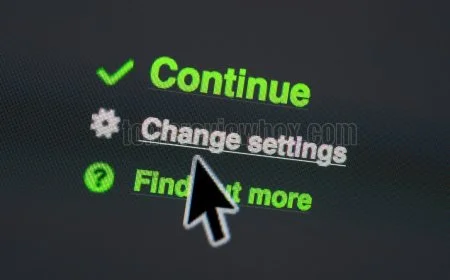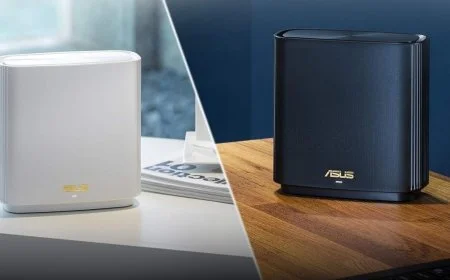How to Reset Your ASUS Notebook PC to Factory Settings: A Simple Step-by-Step Guide
Learn the most effective ways to reset your ASUS notebook PC to factory settings with our comprehensive step-by-step guide.

Ever found yourself stuck with a sluggish Asus notebook PC and thought about hitting that reset button for hard resets or entering laptop recovery mode? You're not alone. Resetting your device to factory settings can feel like giving it a fresh start, breathing new life into its performance, similar to how an Asus laptop restarts or a computer reboots. This guide will walk you through the steps to reset your Asus notebook PC safely and efficiently, ensuring your data is backed up, the computer reboots correctly, and your system runs smoothly afterward without CPU error.
Whether you're dealing with persistent glitches or an error in the Windows operating system, or just want a clean slate, knowing how to reset your Asus notebook is essential. It's easier than you might think with a soft reset, and we're here to help you every step of the way. Dive in and discover how this simple process, with a dedicated reset button or hard reset, can make a world of difference for your trusty device.
Key Takeaways
- Understand the Reset: Familiarize yourself with what a factory reset entails to ensure it meets your needs, whether it's solving performance issues or preparing the device for a new user.
- Backup Important Data: Before initiating a reset, always back up your important files and data to prevent permanent loss.
- Choose the Right Reset Option: Decide between a full or partial reset based on your specific requirements; a full reset erases all data while a partial reset may retain some personal files.
- Follow Step-by-Step Instructions: Use the detailed guide provided for logged-in users to ensure a smooth reset process and avoid common mistakes.
- Reset Without Logging In: If you're unable to log in, utilize alternative methods to initiate a reset, ensuring you can still restore the device to factory settings.
- Troubleshoot Issues: Be prepared to address common problems that may arise during the reset process by referring to troubleshooting tips shared in the article.
Understanding Factory Reset
What is a Factory Reset
A factory reset restores a device to its original system state. This process removes all user data and installed applications. It reinstalls the operating system and default software that came with the device through a factory reset process. Users often choose this option when their notebook experiences significant issues. The factory reset ensures that everything is wiped clean, providing a fresh start.
Why Perform a Factory Reset
Performing a factory reset can resolve persistent software issues or malware infections. It clears out any unwanted programs and files that might be causing problems. This process also improves system performance by removing clutter. A reset helps in speeding up an old or sluggish device. Moreover, it prepares the notebook for resale or transfer of ownership, ensuring no personal data remains.
When to Consider Resetting
Consider resetting your Asus notebook if you experience frequent crashes or system errors. Such issues might indicate deeper problems within the system. If troubleshooting steps fail to resolve these issues, a factory reset could be the solution. Also, before selling or giving away your notebook, always perform a reset. It protects your privacy and ensures the new owner receives a clean device.
Preparing for the Reset
Backup Important Files
Before starting the reset process, backup your important files. Resetting will erase all existing data on your Asus notebook PC. Personal documents and media are at risk. Use external storage devices like USB drives or external hard disks for backups. Cloud services such as Google Drive or Dropbox also offer secure storage options. They provide easy access to files from any device.
Backing up ensures that no valuable information is lost during the reset. It can save time and stress later.
Ensure Sufficient Power Supply
A stable power supply is crucial when performing a reset. Connect your notebook to a reliable power source before you begin. Battery depletion during the reset process can cause interruptions. This could lead to incomplete resets or system errors.
For added safety, consider using an uninterruptible power supply (UPS). A UPS provides continuous power even during outages. It prevents sudden shutdowns that might disrupt the reset.
Verify Software and Driver Updates
Checking for software and driver updates is essential before initiating a reset. Updates often fix bugs and improve system performance. Make sure that your drivers are up-to-date to prevent post-reset issues.
Outdated drivers can cause hardware malfunctions after resetting. Keeping everything updated helps in maintaining system stability. The updates ensure that your Asus notebook functions smoothly once restored to its original system state.
Full vs Partial Reset Options
Difference Between Full and Partial
A full reset involves erasing all data and settings on an Asus notebook PC. This option returns the device to its original factory state. It removes everything, including personal files, applications, and custom settings. A comprehensive reset operation is suitable when selling or giving away the device.
A partial reset retains some user data or settings. This option might keep certain files or apps while restoring system settings to default. It is useful for troubleshooting minor issues without losing all personal information.
Choosing between these options depends on the situation. A full reset is ideal for a fresh start or if the device has serious issues. A partial reset works well for minor glitches or performance improvements without complete data loss.
Pros and Cons of Each Option
A full reset offers several benefits. It thoroughly cleans the device, removing viruses and unwanted software. This can improve performance significantly. However, it also has drawbacks. The most significant is the loss of all personal data and installed applications.
On the other hand, a partial reset has its advantages. It minimizes data loss by retaining some files and settings. This makes it a less drastic option for users needing quick fixes. However, it may not solve severe problems as effectively as a full reset.
Considering these factors helps in deciding which reset option suits your needs best.
Impact on Data and Settings
Performing a full reset deletes all personal files from the Asus notebook PC. Documents, photos, music, and other saved items will be removed entirely. It's crucial to back up important data before proceeding with this option.
System settings will revert to their default state after both types of resets. Customizations like desktop backgrounds, network configurations, and language preferences will be lost. Users must reconfigure these settings manually after resetting.
Installed applications will also be removed during a full reset. Any software added after purchasing the device won't remain. Reinstalling them is necessary if they are still needed post-reset.
Step-by-Step Guide for Logged-In Users
Access Recovery Settings Menu
To begin resetting your Asus notebook PC, press F9 during boot. This action will take you into the recovery mode. If this method does not work, there are alternative ways to access the recovery settings. You can navigate through the Windows settings menu. Go to "Settings," then select "Update & Security." From there, choose "Recovery" and follow the prompts.
It's crucial to follow these steps correctly. Mistakes can lead to unintended consequences, like loss of data or system errors. Make sure to double-check each step as you proceed.
Choose Reset Option
Once in the recovery settings, you'll need to choose between a full or partial reset. A full reset will erase all data and return the system to its original state. This option is useful if you're experiencing significant issues or preparing the device for a new user.
A partial reset keeps personal files but removes apps and settings. It is less drastic and might be enough if minor problems arise. Consider your personal needs carefully before making a decision. Think about what data is important and whether it has been backed up properly.
Follow On-Screen Instructions
After selecting your preferred reset option, it's essential to read each on-screen prompt carefully. These instructions guide you through the process and ensure that you confirm your selections accurately.
Confirming selections helps avoid any unintended actions that could affect your data or system configuration. The process is generally straightforward, with clear guidance provided at each step.
Reset Without Logging In
Use Advanced Startup Options
You can access advanced startup options through Windows settings. Start by pressing the power button on your ASUS notebook PC. Hold the Shift key and click Restart. This opens the Advanced Startup menu.
In this menu, you find features like system restore and startup repair. System restore helps revert your system to a previous state without losing personal data. Startup repair fixes problems that prevent Windows from loading correctly. These tools are useful for troubleshooting before performing a full reset.
Boot from Recovery Drive
Creating a recovery drive is another option. Use a USB or DVD with at least 16GB of space. On another computer, search for "Create a recovery drive" in Windows settings. Follow the prompts to load recovery files onto your drive.
Once ready, insert the recovery drive into your ASUS notebook PC. Restart the computer and press F2 or Esc repeatedly to enter BIOS settings. Change the boot order to prioritize the USB or DVD. This allows you to boot from the recovery drive and initiate the reset process.
This method serves as an alternative if internal recovery fails. It provides a way to restore factory settings when other options are unavailable.
Execute Reset Command
For advanced users, executing a reset command in Command Prompt is possible. Start by booting into Advanced Startup Options as previously explained. Select Troubleshoot, then Advanced Options, and open Command Prompt.
Enter specific commands to initiate a reset. The command systemreset -factoryreset begins the process of returning your ASUS notebook PC to factory settings. This method requires precision, as incorrect commands can lead to system issues.
Advanced users should be cautious when using this method. Mistakes might result in data loss or further complications. Only proceed if confident in navigating command-line instructions.
Troubleshooting Common Issues
Resolve Errors During Reset
Errors can occur during the reset process of an ASUS notebook. One common issue is an incomplete reset, which may stop the process midway. This often results from corrupted files or insufficient power supply. To solve this, ensure your device is connected to a stable power source. Retry the reset by selecting "Reset this PC" under recovery options in settings.
If the problem persists, check the hardware components. Loose connections or faulty RAM might be causing errors. Tighten any loose parts and consider replacing damaged ones. For persistent issues, consulting ASUS support can provide tailored solutions. Their expertise can help resolve complex errors effectively.
Fix Boot Issues Post-Reset
Boot issues may arise after resetting your ASUS notebook. Start by checking the BIOS settings to ensure the correct boot order. The hard drive should be prioritized over other devices. Access BIOS by pressing F2 during startup and adjust settings as needed.
Using recovery tools like Windows Recovery Environment can repair boot sectors. These tools fix corrupted files that prevent normal startup. If these steps don't work, reinstalling the operating system might be necessary. This ensures all system files are intact and functional.
Address Software Installation Problems
After a reset, reinstalling essential software is crucial for optimal performance. Some programs may not function correctly if they aren't compatible with the new system setup. Ensure that each software version matches your operating system's requirements.
Downloading the latest versions from official sources guarantees compatibility and security. Outdated versions might have bugs or vulnerabilities that affect performance. Always verify that installations are complete and free of errors before use.
Data Loss Considerations
Understand Data Erasure Risks
Data erasure during a factory reset might not be permanent. Special tools can recover data even after a reset. This poses privacy concerns if the notebook is sold or given away. Sensitive information could be accessed by others. Using secure erase tools is recommended for sensitive data. These tools overwrite data multiple times, making recovery difficult.
Use Data Recovery Tools
Several tools can help recover lost files after a reset. They scan the hard drive for recoverable data. However, these tools have limitations. Some files may be corrupted or only partially recovered. Professional services are suggested for critical data recovery. Experts have advanced equipment and techniques to retrieve important files safely.
Protect Sensitive Information
Encrypting sensitive files before backup adds an extra layer of security. Encrypted files are harder to access without the correct key. Securely wiping data before performing a reset is crucial. This ensures that personal information is not left behind. Protecting personal information should always be a priority when resetting devices.
Final Remarks
Resetting your ASUS notebook to factory settings can be a game-changer. It’s like hitting the refresh button on your device, clearing out clutter, and solving nagging issues. By following our step-by-step guide, you ensure a smooth reset process whether you're logged in or not. Remember, backing up your data is crucial to avoid any nasty surprises. You've got the power to troubleshoot common hiccups and make informed choices between a full or partial reset.
Don't leave it to chance—take control of your tech life. A factory reset isn't just about fixing problems; it's about starting fresh. Dive into the process with confidence, knowing you've got the know-how to handle whatever comes your way. So why wait? Give your ASUS notebook the reboot it deserves today. If you found this guide helpful, share it with friends who might need a tech boost too!
Frequently Asked Questions
What is a factory reset on an Asus notebook PC?
A factory reset restores your Asus notebook to its original settings. This process removes all personal data and installed applications, returning the device to its out-of-the-box state.
How should I prepare before performing a factory reset?
Backup important files and data. Ensure your device is fully charged or connected to power. Know your login credentials for reinstallation of apps post-reset.
What are the differences between full and partial reset options?
A full reset erases all data, settings, and applications. A partial reset might retain personal files while removing apps and custom settings.
How can I perform a factory reset if I'm logged into my Asus notebook?
Go to Settings > Update & Security > Recovery. Select "Reset this PC" and follow the prompts. Choose between keeping files or removing everything.
Can I reset my Asus notebook without logging in?
Yes, restart your device and press F9 during boot-up. Follow the on-screen instructions to access recovery options for a factory reset.
What should I do if I encounter issues during the reset process?
Ensure your device is plugged in. Restart and try again. If problems persist, consult Asus support or visit their official website for guidance.
Will I lose all my data after a factory reset?
Yes, a factory reset deletes all personal data and installed apps. Always back up important files to an external drive or cloud storage beforehand.
What's Your Reaction?







































![MacBook Pro M5: All the features and specs you need to know [LEAKS REVEALED]](https://tomsreviewbox.com/uploads/images/202502/image_430x256_67bd6d7cd7562.jpg)


























